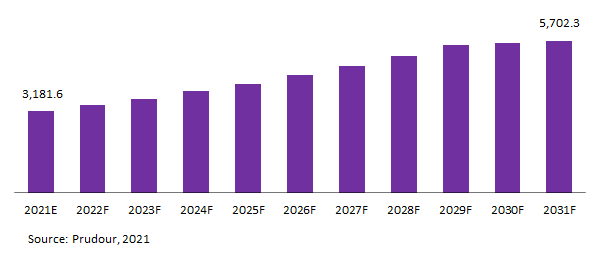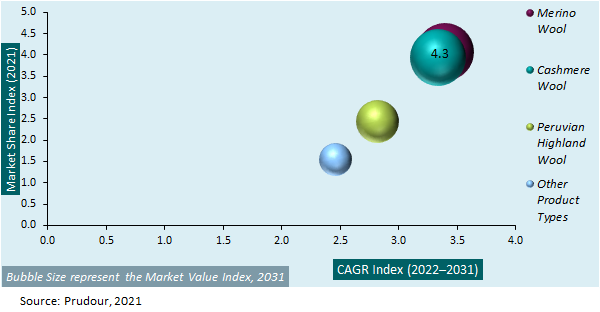Global Wool Worsted Yarn Market By Product Type (Marino Wool, Cashmere Wool, Peruvian Highland Wool and Other Product Types), By Region, and Key Companies - Industry Segment Outlook, Market Assessment, Competition Scenario, Trends and Forecast 2021-2031
- Published date: March 2023
- Report ID: 14374
- Number of Pages: 217
- Format:
- keyboard_arrow_up
The increase in demand for clothing made of wool yarn textiles is projected to boost consumption of worsted wool yarn materials
Market.US announces publication of its most recently generated research report titled, “Global Wool Worsted Yarn Market by Product Type (Marino Wool, Cashmere Wool, Peruvian Highland Wool and Other Product Types) – Global Forecast to 2031”, which offers a holistic view of Global Wool Worsted Yarn Market through systematic segmentation that covers every aspect of the target market.
Global Wool Worsted Yarn Market is projected to be US$ 3,181.6 Mn in 2021 to reach US$ 5,702.3 Mn by 2031 at a CAGR of 6.1%.
Wool worsted yarn is high-quality wool that has been manufactured from long-staple pasture wool of sheep breeds including Teeswaters, Old Leicester Long wool, and Romney Marsh. These yarns are distinguished from other woolen yarns by their weight, kind, and quality. Worsted woolen yarn produces fabric that is stronger, smoother, and finer than regular wool.
Wool yarn is widely used in the production of clothing and textiles. It is also mixed with different yarns to manufacture diverse clothing such as coats, socks, sweatshirts, etc. Merino wool is extensively utilized in the production of clothing due to favorable qualities such as lightweight, heat resistance, etc.
trending_up Total Revenue in 2018$ 3,181.6 Mn
trending_up Market CAGR of the Next Ten Years6.1%
no_encryption Market Value (US$ Mn), Share (%) and Growth Rate (%) Comparison 2012-2028Purchase this report or a membership to unlock the market value (US$ Mn), share (%) and growth rate (%) comparison for this industry.- By Type
- By Region
- By Application
no_encryption Leading Companies Financial HighlightsPurchase this report or a membership to unlock the leading companies financial highlights for this industry.trending_up Market Revenue of the Next Ten Years$ 5,702.3 Mn
The growing customer preference for upholstery textiles to improve the look of their homes also has a positive influence on the wool yarn industry, since wool yarn is widely used in the production of curtains, rugs, and other home furnishings.
Global Wool Worsted Yarn Market Revenue (US$ Mn), 2021–2031

An increasing number of consumers of the textile sector are developing a preference for high-quality wool, as such competition is also increasing as yields and trends improve. The requirement of wool yarn with enhanced quality and characteristics, such as lightweight and comfort, continues to push manufacturers and sheep farmers to develop and expand their position in the textile sector.
Additionally, owing to the increasing textile sector, favorable trade regulations and the manufacturing of high-quality wool yarn are boosting textile exports. As wool yarn is widely used in textile production, this is likely to have a substantially positive influence on the wool yarn market.
These yarns are not carded, but rather washed, gilled, and combed using hot long-tooth metal combs before being oiled and spun. Therefore, worsted woolen yarn is more expensive than regular woolen yarn because the sheep from whom the wool is collected are of a better breed.
Worsted fabric also requires more processing, thus its price tends to be higher. Worsted cloth is mostly used for men’s suits. However, higher production costs and longer manufacturing times for worsted wool yarn materials are expected to limit production volumes, and subsequently, market growth prospects in the process.
Global Wool Worsted Yarn Market Attractiveness Analysis by Product Type, 2015–2031

The global wool worsted yarn is segmented on the basis of product types such as, merino wool, cashmere wool, peruvian highland wool, other product types and it is further sub-segmented by the application such as apparel, upholstery, blankets and, other applications. Under the product type market segmentation, the merino wool segment is expected to account for the majority revenue share of this target industry.
On the basis of regions, the market is segmented as North America, Europe, Asia-Pacific, South America, and the Middle East & Africa. Market in North America is projected to account for a major share, in terms of revenue, of the global wool worsted yarn market, and is projected to maintain its respective market position over the forecast period.
The research report on Global Wool Worsted Yarn Market includes profiles of some of the major companies such as Indorama Ventures Public Company Limited, Grasim Industries Limited, Südwolle Group, Shandong Hengtai Textile Co. Ltd., Novita Oy, Oswal Woollen Mills Limited, Laxtons Limited, Brown Sheep Company Inc., The Fibre Co, Kapotex Industries Pvt. Ltd., Brooklyn Tweed, and other key players.
Segmentation for the Global Wool Worsted Yarn Market Based on Product Type by Application, and Region
Based on Product Type by Application
- Merino Wool
- Apparel
- Upholstery
- Blankets
- Other Applications
- Cashmere Wool
- Apparel
- Upholstery
- Blankets
- Other Applications
- Peruvian Highland Wool
- Apparel
- Upholstery
- Blankets
- Other Applications
- Other Product Types
- Apparel
- Upholstery
- Blankets
- Other Applications
Based on Region
- North America
- Europe
- Asia-Pacific
- South America
- MEA
Based on Key Player:
- Indorama Ventures Public Company Limited
- Grasim Industries Limited
- Südwolle Group
- Shandong Hengtai Textile Co. Ltd.
- Novita Oy
- Oswal Woollen Mills Limited
- Laxtons Limited
- Brown Sheep Company Inc.
- The Fibre Co
- Kapotex Industries Pvt. Ltd.
- Brooklyn Tweed
- other key players.
For the Wool Worsted Yarn Market research study, the following years have been considered to estimate the market size:
Attribute Report Details Historical Years
2016-2020
Base Year
2021
Estimated Year
2022
Short Term Projection Year
2028
Projected Year
2023
Long Term Projection Year
2032
Report Coverage
Competitive Landscape, Revenue analysis, Company Share Analysis, Manufacturers Analysis, Volume by Manufacturers, Key Segments, Key company analysis, Market Trends, Distribution Channel, Market Dynamics, COVID-19 Impact Analysis, strategy for existing players to grab maximum market share, and more.
Regional Scope
North America, Europe, Asia-Pacific, South America, Middle East & Africa
Country Scope
United States, Canada and Mexico, Germany, France, UK, Russia and Italy, China, Japan, Korea, India and Southeast Asia, Brazil, Argentina, Colombia etc.Saudi Arabia, UAE, Egypt, Nigeria and South Africa

- Indorama Ventures Public Company Limited
- Grasim Industries Limited Company Profile
- Südwolle Group
- Shandong Hengtai Textile Co. Ltd.
- Novita Oy
- Oswal Woollen Mills Limited
- Laxtons Limited
- Brown Sheep Company Inc.
- The Fibre Co
- Kapotex Industries Pvt. Ltd.
- Brooklyn Tweed
- other key players.
- settingsSettings
Our Clients
| Single User $4,599 $3,499 USD / per unit save 24% | Multi User $5,999 $4,299 USD / per unit save 28% | Corporate User $7,299 $4,999 USD / per unit save 32% | |
|---|---|---|---|
| e-Access | |||
| Report Library Access | |||
| Data Set (Excel) | |||
| Company Profile Library Access | |||
| Interactive Dashboard | |||
| Free Custumization | No | up to 10 hrs work | up to 30 hrs work |
| Accessibility | 1 User | 2-5 User | Unlimited |
| Analyst Support | up to 20 hrs | up to 40 hrs | up to 50 hrs |
| Benefit | Up to 20% off on next purchase | Up to 25% off on next purchase | Up to 30% off on next purchase |
| Buy Now ($ 3,499) | Buy Now ($ 4,299) | Buy Now ($ 4,999) |










